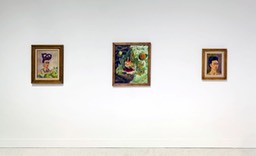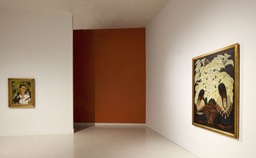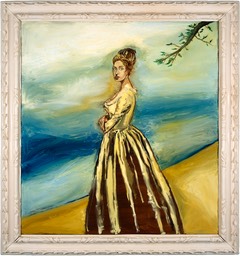Audio interview with Bonnie Clearwater, director of NSU Art Museum Fort Lauderdale for a May, 2015 Miami Herald story. Clearwater gives insight into some of the themes and individual works in the exhibition, Kahlo, Rivera + Mexican Modern Art.
Kahlo, Rivera + Mexican Modern Art
georgefishman@me.com
Relationships are the coin of the realm in the museum world, and that’s how this exhibition came to be. Presenting Kahlo, Rivera + Mexican Modern Art gave NSU Museum director Bonnie Clearwater a choice opportunity to inaugurate the Stanley and Pearl Goodman Center for the Study of Latin American Art (which will be housed at the museum), while featuring this collecting couple’s recent donation of 75 artworks by modern Latin American artists.
Good timing also helps.
Another collection, especially renowned for its Frida Kahlo self-portraits, was amassed by Jacques and Natasha Gelman, beginning in the early 1940s. Their collection is managed by the Vergel Foundation under the direction of Robert Littman, who mentored Clearwater at the start of her career. Shortly after arriving at the NSU Museum, Clearwater learned that major Gelman artworks would soon travel to South Korea, but, “there was this little window of opportunity to show the collection in South Florida.”
Pairing the two collections was a natural “to bring awareness to our collection and be able to fill out the story of Mexican Modern Art.”
Beyond the Mexican show, potent synergies circulate throughout the museum’s current exhibitions. The notorious Rivera-Kahlo marital drama — featuring multitudinous affairs, reconciliations, divorce and remarriage — underlies these celebrated artists’ work on the museum’s first level, but visitors will find the results of other love-inspired creativity upstairs.
Pablo Picasso’s prodigious romantic and artistic prowess is expressed in the Vollard Suite and 347 Series prints, as well as his playfully inventive ceramics, created between 1931 and 1971. Audaciously identifying himself with virile Greek deities, his depictions of sensual nudes and romps in the studio reverberate not only with Frida and Diego’s drama — but also with the gigantic works by Julian Schnabel hanging nearby. Schnabel’s mini-grand exhibition (only five paintings, but enormous) includes two portraits of Olatz Lopez Germendia Schnabel that dominate the viewer and bestow the model — and by implication, the artist — with heroic stature.
Schnabel’s relationship with his ex-wife had at least one episode of high drama. His surprise gift of a large painting that featured her name served as a formidable courtship offering. They got married, but not forever. Today, the celebrated duo remains linked by children and by art. Following Schnabel’s central place in the recent NSU exhibition Café Dolly: Picabia, Schnabel, Willumsen, Olatz Schnabel pledged a nine-foot-tall portrait of herself to the museum. Additionally, she has loaned four large-scale works, including a 2004 portrait and Schnabel’s remarkable 2012 homage to his friend, artist Mike Kelley — on view adjacent to the Picasso show.
“All three exhibitions are about how love inspires the art and how the art is then able to make that emotion manifest in their work, so that when the viewer sees it we know what love is; we can feel it,” Clearwater said.
Schnabel assumed prominence among the Neo-expressionists of the ’80s; his works — along with those of David Salle, Eric Fischl, Robert Colescott and others — embodied a vehement reaction against conceptual and minimalist art and are characterized by rough handling of representational subjects, (often borrowing from historical imagery) and using widely diverse materials.
Schnabel’s broken plate paintings elicited much praise and scorn. His sometimes brash public persona links him to other “larger-than-life” artists, like Picasso, Rivera and Kahlo. And his connection to Mexico runs deep. The family’s move from Brooklyn to Texas gave the young Schnabel ready access to Mexico, where his encounter with the works of Rivera and Kahlo was transformative, revealing art’s potential to engage both global and intimate concerns. Recently while visiting Fort Lauderdale, according to Clearwater, he “went crazy” for Kahlo’s My Doll and Me.
The Gelman and Goodman collections occupy adjacent ground-level gallery spaces, but history and personalities entwine them. The Gelmans, both Eastern European Jews, met in Mexico City in 1938 and were unable to return to Europe because of the rise of fascism. Jacques was already a successful film distributor and art collector in Europe, achieving equal stature in Mexico City — notably with the comic actor Cantinflas. His circle of friends included the already-famous Rivera, whose murals festooned many public buildings and expressed the national political fervor of post-revolutionary Mexico.
Rivera, along with colleagues Alfredo Martinez, David Siqueiros, Rufino Tamayo and José Orozco, dominated the new generation of Mexico’s modernist era. They were joined by a growing cadre of talented European émigrés — many of them Surrealist painters — whom the Gelmans also “adopted.” First one surrealist came, then the others, forming a lively intellectual cadre surrounding Kahlo, Rivera and their fellow Mexican nationals. Rivera encouraged Kahlo to adopt the indigenous dress and jewelry that became her trademark and are in evidence throughout the show.
Rivera’s two mural designs from 1933 are representative of the Goodmans’ documentation of the post-Revolution Mexican muralist movement that embraced the nation’s indigenous past while embodying new populist ideals. The government supported murals as a way of bringing these ideals to a largely illiterate public.
Rivera was already a big collector of pre-Columbian art, and upon returning to Mexico from Europe, he stopped painting as a Cubist. Both his easel paintings and murals extol peasants and laborers. Intended for a university chemical-sciences facility, his designs depict conveyor belts, glass blowing and gamma radiation, among other industrial processes. Two Amazon-like figures, bearing eyes on their right palms, dominate these complex, socially oriented images. They flank a romantic page from Kahlo’s diary, reflecting the dichotomy of outward vs. inward focus that generally distinguishes the two artists.
Kahlo’s 1937 portrayal of Diego is affectionate but not overly flattering. She presents a man who appears reflective and self-assured as he looks off into the distance, rather than at the painter or viewer. By contrast, her arresting Self-portrait with Necklace goes eye-to-eye with the viewer. She unflinchingly captures her bird-wing central eyebrow and delicate mustache. A lace collar conveys the courtly fussiness of a colonial-era painting and contrasts with the rough gray stones encircling her neck. It’s easy to see why Natasha Gelman found her irresistible.
The Gelmans collected friendships and artworks for 40 years. Commissioned portraits of the glamorous Natasha, which “paid the rent” for select artists, are prominent in the exhibition. It’s particularly revealing to compare Rivera’s and Kahlo’s treatments.
“The way that Frida paints the fur around Mrs. Gelman's neck, it is so tactile and plush,” noted Clearwater. You really feel you could stick your hand into that beautiful fur — in contrast with this very mask-like hard face where there’s absolutely no expression in the eyes. The softness of the fur again contrasts with the almost chiseled curls that frame her face.
Rivera took a different tack: “She is surrounded by these long stalks of white calla lilies, which are actually echoing her dress, so she becomes a kind of calla lily, Clearwater said. “And far from the mask-like face that Frida painted, we have a very soft, light-skinned woman with soft blonde curls cascading down, and where Frida had the sort of harsh or blank stare, we see a very seductive look in Mrs. Gelman's eyes in the Rivera portrait.”
Besides Kahlo, the Goodman Collection features three other highly regarded women artists who ascended during this period in Mexico: Leonora Carrington, Remedios Varo and Alice Rahon.
Varo moved to Mexico in 1941. Working in the Surrealist mode, her mysteriously draped and sensuous — and decidedly female — Minotaur holds a key, suggestive of escape from her labyrinthine confinement.
About Carrington, Clearwater said, “We have her first painting, painted in Mexico City, and it’s all about her leaving the ruins of the Old World in coming to this New World not knowing what to expect. In the New World there’s this empty dress just waiting for her to fill it.”
Kahlo’s visionary work bears a kinship to surrealism and presages magical realism. Her Love Empress of the Universe from 1949 carries her introspective drama to the cosmic realm. A cracked and lactating earth mother floats among various symbols of light and dark, fertility and barrenness. Portrayed as an oversize baby, Rivera is given a third eye and a flame. Kahlo cradles him while blood pours from her heart and tears from her eyes. Gravely injured as a teenager, Kahlo could never bear children, though she fervently wished to have Rivera’s. In this complex work, both intensely personal and cosmic forces strive for resolution.
Upon first encountering Kahlo’s work at the Grey Gallery at New York University in the early 1980s (where Littman was director), Clearwater was unfamiliar with the Kahlo-Rivera romantic drama that threatened to overshadow the work itself. The NSU exhibition’s wall texts and excellent catalog offer ample contextual information, but Clearwater really wants new visitors to “have the same fortunate experience I had of seeing these works for the first time and having the shock of seeing them in person and how beautiful they are.”
Viewing the paintings in person is different from a print or online experience, and extensive display of contemporaneous photographs reinforces our sense of the artists as real — if exceptional — people.
In one image by Bernard Silberstein, Rivera is standing behind Kahlo’s chair and watching her develop a self-portrait. Notably, at that moment, the famous miniature representation of Rivera on her forehead was not yet present, but the completed painting hangs just a few steps away. Some commentators believe that Rivera’s influence was stifling, but Clearwater notes that third eyes appear frequently in Kahlo’s work and perhaps, in this painting, “Diego as her third eye is a way of opening up the world and the universe to her, rather then this more oppressive interpretation.”
Clearwater has known the Goodmans since 1991. By then, most of the “first generation” of Mexican modernists had died, but this was still before Latin American art became a major market category. “Their goal was to put together a comprehensive collection,” said Clearwater, “with the finest examples they could acquire at the time.”
They started with a Siqueiros drawing. As they continued to build, they realized the collection belonged in a museum. Amassing important works that could tell the story of Mexican modern art was their goal. It continues with such examples as the 2002 Inner Dialogue video by Yasumasa Morimura.
The wall of works by Surrealist émigrés underscores the global connections at work — then and now. “It’s not an insular art community. It’s one very much in contact with all of Latin America, with Europe and the U.S.,” said Clearwater. The Goodman Collection and study center continue to grow, and remind us of South Florida’s cultural and historical links to the entire hemisphere.
Some would say that with a little work, common threads can be traced among any three exhibitions, but the current set at NSU, in which artists document the personal and universal quest for love, invention and immortality, makes the effort particularly worthwhile and pleasurable.
Listen to a pair of director Clearwater’s commentaries.bitly.com/BonnieClearwater_MexicanModernism
IF YOU GO
What: ‘Kahlo, Rivera + Mexican Modern Art’
When: Through May 31
Where: NSU Museum of Art Fort Lauderdale; One E. Las Olas Blvd., Fort Lauderdale
Info: 954.525.5500; www.moafl.org/
What: “Julian Schnabel: Portrait of Olatz”
When: Through Nov. 1
What: “Pablo Picasso: Painted Ceramics and Works on Paper, 1931-71”
When: Through Nov. 1
Read more here: http://www.miamiherald.com/entertainment/visual-arts/article21177774.html#storylink=cpy


